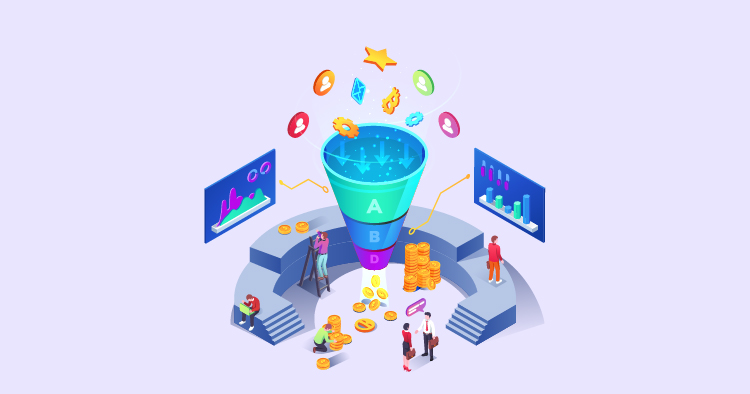The concept of a sales funnel is crucial for businesses looking to optimize their sales process and boost conversion rates. A sales funnel comprises various stages that potential customers pass through, from initial awareness to the final purchase decision. Understanding these stages allows businesses to tailor their marketing strategies effectively, ensuring they engage with customers at the right time with the right message. This strategic approach can increase sales, customer loyalty, and overall business growth. In this article, we’ll delve into the intricacies of the sales funnel stages and how businesses can leverage them for success.
What is a Sales Funnel?
A sales funnel visualizes and understands a customer’s steps, from learning about your product or service to purchasing. It’s like a roadmap that shows the customer’s journey, starting with the initial discovery and ending with the decision to buy. This concept is essential for businesses because it helps them turn someone who is just looking into a paying customer.
Knowing the different parts of a sales funnel helps businesses tailor their marketing efforts to each step. This means they can create the right experience for potential customers at each point in their journey. For example, talking to someone who’s just heard about your product will differ from engaging with someone ready to buy. Understanding the sales funnel helps businesses connect with customers better, which can lead to more sales and loyal customers.
Top of the Sales Funnel: Awareness Stage
The first part of the sales funnel is the Awareness Stage. This is when people first find out about your business or what you offer. It’s a critical time because it’s your chance to make a solid first impression. The primary goal here is to grab the attention of the people you want to reach and stick in their minds.
At this stage, you’ll want to use strategies that help more people learn about you. This could include writing helpful blog posts, posting on social media, or ensuring your website appears in search engine results. The idea is to create content that draws people in and makes them interested in what you say.
To make the most of the Awareness Stage, it’s wise to look at data to see where your visitors are coming from. Then, you can focus on doing more of what’s working. Make sure your messages are clear and exciting and that they speak directly to what your potential customers are looking for. This way, you can set the stage for them to move further down the funnel toward becoming customers.
Middle of the Sales Funnel: Interest and Consideration Stages
When potential customers reach the middle of the sales funnel, they’re already curious about what you offer and are considering purchasing. This is a vital time to connect with them and help guide their decision. It’s where you get to know each other better.
Sharing more about your products or services is essential to keeping these prospects interested. You might send emails with helpful information, publish articles or blog posts that answer their questions, invite them to online workshops, or check in to see if they need more information. You aim to help them, answer their questions, and show reliability.
Struggling with Digital marketing? Book Your Free Strategy Session!
- 30-Minutes Session
- Expert Insights
- Data-Driven approach
- Optimized Strategies for Your Goals
Trust is a big deal at this stage. You can build it by sharing stories from satisfied customers, showing how your products have helped others, or sharing your knowledge and experience. Every content should be thoughtful and relevant to what the potential customer wants to know, easing worries about choosing your product.
Bottom of the Sales Funnel: Decision and Action Stages
Customers are almost ready to buy as they move to the bottom of the sales funnel. The goal is to help them take that final step and purchase. This part of the funnel is about making things easy and appealing for the customer.
To turn interested leads into buyers, consider offering special deals, limited-time offers, or bonuses that make your product even more tempting. Make sure that buying from you is easy, with a simple checkout process and various payment options. If they hesitate, be ready to remind them why your product is a great choice, perhaps with a quick summary of its benefits.
Improving the sales process is an ongoing task. Look at previous sales and where people got stuck or lost interest. Maybe the sales team complicated the checkout process or didn’t provide a payment method that worked for the customers. Making changes based on this information can lead to a better customer experience and more sales. Good customer support is also crucial; it shows that you’ll be there for them even after they’ve made a purchase.
Mapping the Customer Journey
When you understand the customer journey, you’re better equipped to market and sell your products or services. It’s like having a map showing where your customers might get lost or decide to continue on the path to buying something from you. By figuring out these critical spots, called touchpoints, you can ensure you’re there to help guide them in the right direction.
To find these touchpoints, you might ask customers for feedback, look at survey results, or use tools showing how people interact with your website. When you improve these touchpoints, customers have a more enjoyable time interacting with your brand, which can lead them to buy from you.
Data and analytics are your best friends when it comes to determining what your customers like and what they don’t. This information allows you to keep tweaking your sales process to improve it, which can lead to more people buying what you’re selling.
Sales Funnel Stages Explained: A Step-by-Step Breakdown
Every step of the sales funnel is like a new chapter in a book, each with its plot and challenges. Knowing these steps helps you write a better story for your customers, which leads them to purchase.
At the beginning, or the awareness stage, you’re trying to get potential customers to notice you. Then, as they move into the interest and consideration stages, you’re getting them engaged and thinking about whether they need what you’re offering. At the final stages, decision and action, your job is to convince them to choose your product or service.
Struggling with Digital marketing? Book Your Free Strategy Session!
- 30-Minutes Session
- Expert Insights
- Data-Driven approach
- Optimized Strategies for Your Goals
Real stories or case studies can illuminate how to navigate each stage successfully. These stories can show what tactics have worked for other businesses and can give you ideas for your strategy. Whether it’s a small local shop or a big online retailer, these examples can teach you a lot about managing your sales funnel effectively.
Importance of Lead Generation
Lead generation is crucial in the world of sales and marketing. It’s getting people interested in your products or services. By identifying who might want to buy from you and making them aware of what you offer, you’re setting the stage for a successful business.
Small businesses, in particular, can benefit from various strategies to generate leads. These include sharing engaging content online, using social media ads, emailing potential customers, and ensuring your website appears in search results. Tools like customer relationship management (CRM) systems and specialized software can make this process more effective.
To attract suitable leads, you must know your potential customers and what they want. Then, you can create marketing that speaks directly to their interests. This might involve sharing helpful information, designing attractive web pages where customers land when they click on your ads, and displaying positive feedback from other customers.
Nurturing Leads for Success
Once you have leads, it’s time to nurture them. This means building a relationship with potential customers as they consider whether to buy from you. The goal is to support them with the correct information at the right time, helping them move from knowing about your product to deciding to purchase it.
Effective lead nurturing is all about communication. Regular, personalized emails, helpful content, and being there to answer questions can all make a big difference. When people feel informed and supported, they’re more likely to trust your business.
Automation tools can help you keep in touch with leads without doing everything manually. These tools can send out messages at the correct times, but making those messages feel personal is still essential. Combining automation with a personal touch makes you more likely to engage potential customers and turn them into buyers.
Optimizing Sales Funnel Stages for Maximum Conversion
Maximizing conversion rates is crucial for any business, and tweaking your sales funnel can help. Look at each part of the funnel to find where you can improve. It’s like a health check-up for your sales process.
Monitor essential numbers like how many people buy, click, and do what they do on your site. This information points out where you might lose customers. Knowing this, you can decide where to focus your energy to fix things.
You might try more explicit messages to encourage more people to move through the funnel, making your website easier to use or giving a little nudge, like a discount. It’s about making the journey as smooth as possible for your customers.
The Role of Content in Sales Funnel Stages
Think of content as your guide, helping potential customers navigate the sales process. At each step, the content changes to fit the customer’s needs. It’s about giving them the correct information at the right time.
Creating content that hits the mark means understanding what your audience is looking for and providing information that matters to them. This could be through blog posts that answer their questions, videos that show your product in action, or infographics that break down complex ideas.
To make your content work harder for you, it needs to be easy to find online (that’s where SEO comes in), easy to share, and matched to the part of the sales funnel you’re targeting. Keep your content fresh and exciting, and people will return for more.
Leveraging Technology and Tools
Using the right technology and tools can make a big difference in managing your sales funnel. Think of a CRM (Customer Relationship Management) system as a digital Rolodex that does much more than store contact information. It lets you keep track of all your interactions with your customers and potential customers. It’s like having a personal assistant who remembers every conversation, email, and meeting, helping you provide personalized service.
Analytics tools are like having a crystal ball for your business. They let you peek into how your customers behave and what they like, helping you make smarter decisions about where to focus your efforts. Marketing automation platforms are the workhorses that take care of repetitive tasks. They send emails, manage your social media posts, and even help with lead nurturing, freeing up your time to focus on more strategic tasks.
If you’re running a small business, you don’t want to spend a fortune on these tools, so look for affordable, easy-to-use tools that can grow with your company. The best tools integrate well with other software and give you valuable insights into how your sales funnel is performing.
Integrating Sales and Marketing Efforts
Think of your sales and marketing teams as dance partners. When they’re in sync, they move together flawlessly, guiding the customer smoothly from one stage of the sales funnel to the next. But if they’re not aligned, they can step on each other’s toes and confuse the customer.
To keep everyone moving to the same beat, it’s essential that sales and marketing have regular check-ins, share their goals, and track the same metrics. They should plan campaigns together and tell the customer the same story.
How do they stay on the same page? They regularly have meetings and use shared project management tools. Imagine a virtual bulletin board where everyone can see what’s going on, who’s doing what, and when things are due. Plus, when both teams can access the same customer data and insights, they can create a personal and seamless customer experience.
Common Mistakes to Avoid in Sales Funnel Stages
It’s easy to trip up when trying to perfect your sales funnel. Some slip-ups that can slow you down include not paying enough attention to people who’ve shown interest in your product but haven’t bought it yet or when your sales and marketing teams aren’t on the same page. And let’s not forget the gold mine and customer data–if you’re not using it wisely, you’re missing out.
Knowing these pitfalls and how to avoid them can help you fine-tune your approach. And it’s even more helpful when you hear about companies that stumbled, picked themselves up, and got it right. Take, for example, a tech startup churning out lots of content but not seeing any increase in sales. They learned the hard way that they needed to target their content better and ensure it reached the right people. After tweaking their approach, they started seeing a much better conversion rate. Stories like this can show you how to turn a mess-up into a step-up, giving you the confidence to fix your funnel mistakes.
Final Thoughts
As businesses strive to convert leads into loyal customers, mastering the sales funnel stages becomes indispensable. By recognizing potential customers’ unique needs and behaviors at each stage, businesses can craft targeted strategies that guide prospects smoothly toward a purchase. This enhances the customer experience and maximizes the efficiency of marketing efforts and resources. Implementing a well-structured sales funnel is a powerful way to drive business growth and stay competitive in today’s market. Remember, a successful sales funnel involves understanding, engagement, and continuous optimization.



